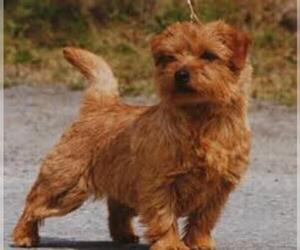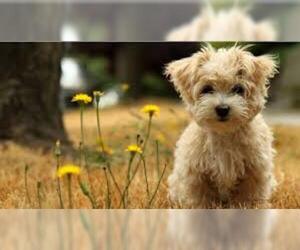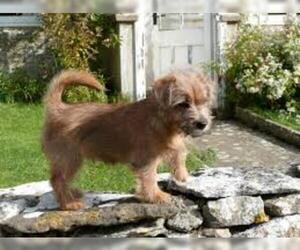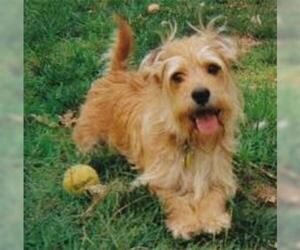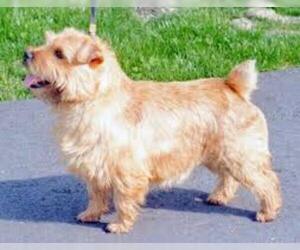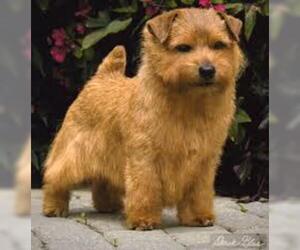
All about Norfolk Terrier dog breed
A.K.A. :Trumpington Terrier, Cantab Terrier, Short Haired Norwich Terrier, Norfolk, Norfolkie, Norfolkie Dog
Size
Grooming requirements
Exercise requirements
Good with other dogs
Watchdog ability
Energetic
Training requirements
Playful
Affectionate
Good with other pets
Good with children
Good with strangers
Winter
Summer
Healthiness
Protective
Life Span
| Pure Breeds | Member |
| Breeds A - Z | N |
| Breeds by Group | Terrier |
| Breeds by Trait | Hypoallergenic Low Shedding |
| Overview: | The Norfolk Terrier is a small, plucky, and affectionate dog breed originating from East Anglia, England, specifically developed for hunting small vermin. They boast a sturdy, compact build, typically weighing 11-12 pounds and standing 9-10 inches tall. Their distinguishing feature is a harsh, wiry coat, which can be red, wheaten, black and tan, or grizzle, requiring regular hand-stripping to maintain its texture and protective qualities. Renowned for their fearless yet friendly temperament, Norfolk Terriers are intelligent, alert, and surprisingly adaptable. They are generally good with children and other pets, making them excellent family companions, and their relatively small size means they can thrive in apartments, provided they receive sufficient daily exercise and mental stimulation. While generally a healthy breed with a lifespan of 12-15 years, they can be prone to certain conditions like patellar luxation or some eye problems, making responsible breeding and regular vet check-ups important. |
F.A.Q.
All You Need to Know About the Norfolk Terrier Breed
The Norfolk Terrier, originating from England, is a delightful and compact companion known for its lively and affectionate temperament. These small but sturdy dogs typically weigh between 11-12 pounds and stand around 9-10 inches tall, featuring a wiry, weatherproof coat and expressive, dark eyes. They are highly adaptable, making them suitable for both families with children and singles, and they thrive in apartment living provided they receive adequate exercise. Their intelligent and outgoing nature makes them relatively easy to train, though a mischievous streak can emerge without consistent guidance. Grooming needs are moderate, requiring weekly brushing and occasional hand-stripping to maintain coat health. Daily walks and playtime are essential to satisfy their moderate exercise requirements. Generally a healthy breed, potential owners should be aware of common health considerations such as patellar luxation and certain eye conditions. Overall, the Norfolk Terrier is a charming, low-shedding breed offering boundless joy and companionship.The average weight for a Norfolk Terrier is 11-12 pounds. Healthy adult Norfolk Terriers typically fall within a range of 11-12 pounds, with minimal noticeable variation between males and females. This compact size contributes to their lively and agile nature, making their healthy weight for Norfolk Terrier consistent across the breed.
Norfolk Terrier Height: What's the Average Size?
Curious about the typical Norfolk Terrier height? These charming little terriers are known for their compact size. On average, a healthy adult Norfolk Terrier stands about 9 to 10 inches tall (measured at the shoulder).While this is the general guideline, individual genetics and gender can lead to slight variations:- Most males and females fall comfortably within this 9-10 inch range, with no significant height difference between the sexes.
- Some individuals might be a tad shorter or slightly taller, perhaps ranging from 8.5 to 10.5 inches, but anything outside of this would be considered uncommon for the breed standard.
Norfolk Terrier Colors:Norfolk Terriers primarily come in a range of reds, wheaten, black & tan, and grizzle. These are the AKC recognized Norfolk Terrier colors and are the most common. * Red: A rich, vibrant red, from light to deep mahogany.* Wheaten: A pale, yellowish fawn to a light, creamy tan.* Black & Tan: A distinctive pattern with a black saddle over the back and tan markings on the head, legs, and underparts.* Grizzle: A mixture of black or grey hairs with red or tan, giving a salt-and-pepper appearance.Rare coat types or exotic Norfolk Terrier variations such as blue, lilac, merle, or chocolate are not characteristic of the breed and are not recognized by major kennel clubs like the AKC. Such variations would indicate an outcross and are not considered standard for the Norfolk Terrier. When searching for Norfolk Terrier colors, focus on the recognized reds, wheaten, black & tan, and grizzle to ensure a purebred Norfolk Terrier.
The Norfolk Terrier personality is characterized by a delightful combination of pluckiness and affection. These small, sturdy dogs possess a temperament of Norfolk Terrier that is generally friendly and outgoing, making them wonderful companions. They are known for their fierce loyalty to their families and thrive on companionship.Norfolks are quite sociable and enjoy being part of the action, whether it's an outing or simply lounging at home. Their adaptability to apartment living is excellent, provided they receive regular walks and mental stimulation; they don't require vast spaces but do need exercise.With children, Norfolks are typically good with children, especially if raised with them and if the children are taught to interact respectfully. Their playful nature often makes them great partners for older, considerate kids. When it comes to other pets, they can coexist peacefully with cats and other dogs, particularly if socialized from a young age. However, their terrier instinct means they may chase small critters outdoors. Overall, the Norfolk Terrier is an intelligent, charming, and surprisingly robust little dog with a big heart.
The Norfolk Terrier temperament is generally described as charming, affectionate, and spirited. These small but mighty dogs are known for their loyal and sociable nature, forming strong bonds with their families. They are typically friendly with people and, while alert, are not usually aggressive.Norfolks are quite adaptable, making them suitable for apartment living as long as they receive adequate exercise and mental stimulation. They thrive on companionship and can be prone to separation anxiety if left alone for extended periods.Regarding behavior with children, Norfolks are generally good-natured and playful, especially with respectful older children. Younger children should be supervised to ensure gentle interactions. Their interactions with other pets can vary; while some live happily with cats, their strong prey drive means careful introductions and supervision with smaller animals are essential. They often enjoy the company of other dogs.Despite their agreeable nature, Norfolks do possess a characteristic terrier stubbornness and an independent streak, which can make training a fun challenge. They are intelligent and eager to please but require consistent, positive reinforcement. They are not overly sensitive but respond best to gentle handling and a firm, fair approach. Overall, the Norfolk Terrier personality traits make them delightful and engaging companion dogs.
Norfolk Terrier Care: Daily Maintenance & Health TipsCaring for a Norfolk Terrier involves moderate commitment to ensure their well-being. This low-energy dog breed requires regular, but not excessive, exercise; daily short walks or indoor play sessions suffice.Grooming Needs: Hand-stripping every 6-8 weeks is essential to maintain their wiry coat and prevent matting, while brushing 2-3 times a week helps remove loose hair. Frequent bathing is not recommended to preserve coat texture.Dietary Considerations: Feed a high-quality, age-appropriate dog food. Weight management is crucial as they can be prone to obesity; avoid overfeeding and limit treats.Wrinkle and Ear Cleaning: Despite not being brachycephalic, regular ear checks and cleaning are important to prevent infections. Their facial wrinkles (if present) should be kept clean and dry to avoid skin irritation.Climate Sensitivity: Norfolk Terriers are generally adaptable but should be protected from extreme heat due to their small size and coat.Common Health Concerns: Be aware of potential skin issues, dental care needs (daily brushing recommended), and patellar luxation. Regular vet check-ups are vital for early detection and prevention. How to care for a Norfolk Terrier effectively involves proactive health monitoring and consistent routine.
Norfolk Terrier Activity Level: Norfolk Terriers are a surprisingly active breed for their size, balancing short bursts of high energy with long periods of rest. They possess a typical terrier zest for life and require consistent daily exercise to stay happy and healthy. Expect at least 30-60 minutes of varied activity each day, which can include brisk walks, supervised playtime in a securely fenced yard, or engaging in scent work and puzzle toys. These clever dogs love to play and thrive on interactive games with their owners, such as fetch, tug-of-war, or even learning new tricks. Their playful nature makes them excellent companions for families who enjoy engaging with their pets. However, it's important to note their brachycephalic (short-nosed) anatomy can make them prone to overheating, especially in warm weather or during strenuous exercise. Always monitor their breathing and avoid overexertion. While they enjoy being active, they also appreciate and need plenty of downtime, often curling up for a long nap after their exercise. This balanced approach to energy makes the Norfolk Terrier suitable for active families who can provide their daily dose of adventure and mental stimulation, as well as households that appreciate a dog capable of both lively play and quiet companionship. They are not a "couch potato" breed but also not a constant high-energy dog, striking a good balance for many lifestyles. For those wondering, "how active are Norfolk Terrier," the answer is moderately active with specific exercise needs.
Norfolk Terriers are not brachycephalic, so brachycephalic dog care practices are generally unnecessary, though basic precautions like avoiding extreme heat and monitoring breathing during intense activity are still helpful. Spinal problems such as intervertebral disc disease (IVDD) are rare but possible, particularly in aging dogs or those with poor conditioning. Their thick coat and energetic temperament also contribute to heat sensitivity, making hydration, shade, and rest breaks essential during warm weather.
Breed Breakdown: What Experts Say About the Norfolk Terrier
I would rate the "Size" trait of the Norfolk Terrier as a 3.Norfolk Terriers are classic small dogs. They typically stand about 9-10 inches tall at the shoulder and weigh around 11-12 pounds. Their body structure is compact and sturdy, but undeniably petite when compared to the vast majority of other dog breeds, even within the companion dog category. While not a "teacup" breed, they are significantly smaller than medium-sized dogs and dwarf large breeds. This makes them exceptionally well-suited for apartment living, as they don't require vast amounts of space. Their compact size also makes them excellent travel companions, fitting comfortably in carriers designed for under-seat airplane travel or in smaller vehicles without issue. For households with space constraints, the Norfolk Terrier is an ideal choice, as they can thrive in smaller homes and are easily managed in confined environments.
I would rate the grooming requirements of the Norfolk Terrier at a 7 out of 10.While not as demanding as some long-haired or heavily coated breeds, the Norfolk Terrier definitely requires consistent and specialized care beyond what you'd consider "low-maintenance." Their defining characteristic is their wiry, double coat, which sheds minimally but absolutely needs regular hand-stripping to maintain its texture, color, and protective qualities. Skipping this will result in a soft, dull coat that's prone to matting and less effective at repelling dirt and moisture. This hand-stripping can be time-consuming and often requires a professional groomer every few months, adding to the maintenance effort. Beyond the coat, their ears need regular checking and cleaning to prevent infections, and their nails grow quickly and require frequent trimming to avoid discomfort. While generally a healthy breed, their denser coat can occasionally hide skin issues if not properly brushed and inspected. Therefore, they are not an "easy to care for" breed when it comes to grooming; they require frequent, specialized attention to keep their coat healthy and their overall appearance in top condition compared to many other companion dogs.
I would rate the Exercise Requirements of the Norfolk Terrier as a 6.While they are small dogs, Norfolk Terriers are not content to be couch potatoes. They possess a surprising amount of energy and the classic terrier drive to explore and engage. They thrive on daily activity, and without it, can become bored and potentially destructive. Their energy levels are moderate to high for their size, and they enjoy sustained movement. They are not brachycephalic, so they generally have good respiratory capacity for their build.Their exercise needs can be met with a combination of daily walks (at least 30-60 minutes, split into a couple of sessions), active playtime in a secure yard, and opportunities for mental stimulation like puzzle toys or training sessions. They are agile and intelligent, and many excel in dog sports like earthdog trials, obedience, or even some agility, though they might not have the stamina for the most demanding agility routines. They certainly require structured routines to stay healthy and mentally stimulated; a simple wander around the block once a day won't be enough. They love to chase and "hunt," so off-leash play in a safe, fenced area is highly beneficial. While they are adaptable and will enjoy a relaxing day occasionally, consistent daily exercise is key to their well-being and prevents them from becoming restless or developing behavioral issues. They are not a breed that thrives with minimal activity.
The Norfolk Terrier, while small, possesses a remarkably robust "watchdog ability," earning a solid 8 out of 10. They are highly alert and keenly aware of their surroundings, rarely missing an unfamiliar sound or sight. Their barking is a key component of their watchdog prowess; they will sound the alarm with a surprisingly deep and persistent bark when anything or anyone unusual approaches their territory. This isn't just yappy, indiscriminate barking; it's a purposeful warning. They exhibit strong territorial instincts, viewing their home and family as their domain to protect. When faced with an unfamiliar person, they are typically not aggressive but will maintain a watchful distance, continuing to bark and make their presence known, effectively deterring rather than engaging. While they are too small to physically stop an intruder, their persistent and unwavering vocal warnings are highly effective at providing meaningful early warnings, making it clear that someone is at the door or even approaching the property, making them far more than a passive companion in this regard.
I would rate the "Good with Other Dogs" trait of the Norfolk Terrier an 8 out of 10.Norfolk Terriers are generally known for their outgoing and friendly personalities, which extends to their interactions with other dogs. They typically enjoy the company of other canines and are often quite adaptable in multi-dog households. They're usually not prone to aggression or excessive dominance, and their playful nature often makes them welcome companions for dogs of various sizes and energy levels, though their terrier tenacity can sometimes lead to energetic play that might be a bit much for very timid dogs. While good socialization from a young age is always beneficial for any breed to ensure positive interactions, Norfolk Terriers tend to thrive in canine company and generally navigate social situations with other dogs quite well, often requiring less intense intervention for peaceful coexistence compared to some other breeds.
I would rate the Norfolk Terrier's "Energetic" trait as a 7 out of 10.Norfolk Terriers are naturally active and spirited little dogs, far from being laid-back couch potatoes. They possess a surprising amount of stamina for their size and are always ready for an adventure. They are highly playful and require a good amount of physical stimulation to keep them happy and well-behaved. They love to run, chase, and explore, and can happily participate in various outdoor activities like hiking or long walks. Their terrier nature means they have a strong prey drive and enjoy engaging in activities that mimic hunting, such as fetch or hide-and-seek.While energetic, they are not typically hyperactive like some larger working breeds. They also have an "off switch" and will enjoy cuddle time after a good play session. Their brachycephalic (short-nosed) anatomy, although present, is generally less pronounced than in some other breeds like Pugs or Bulldogs. This means their stamina and exercise tolerance are usually not as severely affected. However, owners should still be mindful of hot weather and intense, prolonged exercise, as their shorter snouts can make them more susceptible to overheating and respiratory distress compared to dogs with longer muzzles. They generally tolerate moderate exercise well but may struggle with very strenuous, extended activities, especially in warm conditions.
I'd rate the Norfolk Terrier's "Training Requirements" a 6 out of 10.While intelligent and eager to please their owners, Norfolk Terriers possess a strong independent streak and typical terrier tenacity that can translate into stubbornness during training. Their attention span can be moderate, easily distracted by interesting smells or sights, which requires a trainer to be engaging and consistent. They respond very well to positive reinforcement, but a firm, fair, and consistent approach is crucial to overcome their tendency to test boundaries. They are not typically beginner-friendly in the sense of being a "train themselves" dog; a novice owner might find their spirited nature challenging without structured routines and a good understanding of canine learning. They require an owner who can be patient, consistent, and creative in keeping training sessions fun and rewarding, rather than highly experienced handling, but certainly not a hands-off approach.
I'd rate the "Playful" trait of the Norfolk Terrier a solid 9 out of 10.Norfolk Terriers are incredibly spirited and embody the fun-loving terrier personality. They possess a high typical activity level, always ready for a game, and absolutely adore interactive play with their owners. Their attention-seeking behavior often manifests as nudging a toy into your hand or wiggling excitedly for a walk. They respond to toys and playtime with boundless enthusiasm, easily entertained by a squeaky ball or a game of fetch. Their overall enthusiasm in daily life is infectious, making them naturally spirited and far from laid-back compared to many other companion dogs, constantly seeking engagement and adventure.
I would rate the "Affectionate" trait of the Norfolk Terrier as a 9 out of 10.Norfolk Terriers are renowned for their incredibly loving and people-oriented nature, making them highly desirable companion dogs. Their desire for human companionship is strong; they genuinely thrive on being part of the family unit and are not content to be left in isolation. Physical closeness is a hallmark of the breed – they are very much lap dogs, enjoying cuddles and often seeking out a comfortable spot near or on their owners. This breed exhibits deep loyalty, often forming strong bonds with their primary caregivers, and they are surprisingly sensitive to their owner's emotions, often offering comfort during times of stress. The "velcro dog" stereotype certainly applies, as they tend to follow their family members from room to room, preferring to be in the same space. While they possess the typical terrier spunk and independence for their size, this is almost entirely overshadowed by their profound need and capacity for affection. They truly thrive on attention and love, making them one of the more overtly affectionate terrier breeds, far less independent than some of their larger or more driven terrier cousins.
I'd rate the Norfolk Terrier's "Good with Other Pets" trait a 6 out of 10.While generally adaptable and outgoing, their strong terrier prey drive, particularly towards smaller, quick-moving animals like cats, is a significant factor. With other dogs, they are typically friendly and playful, especially if socialized early. However, their assertive terrier nature means they won't back down from a challenge, and resource guarding can emerge if not managed. They are not naturally born to be extremely pet-friendly with all types of animals and require dedicated training and consistent supervision to coexist peacefully in multi-pet households, especially with cats or pocket pets. They can certainly be successful, but it's not a given and takes effort.
The Norfolk Terrier rates a 7 out of 10 for "Good with Children."Norfolk Terriers are generally good with children, especially if raised with them from a young age. They possess a playful and affectionate nature, often enjoying games and interaction with respectful children. Their sturdy build can make them more tolerant of unintentional roughhousing from toddlers than some more delicate breeds. They are also known for being quite patient, a valuable trait when dealing with the unpredictable energy of kids.However, their terrier instincts mean they can have a low tolerance for being teased or roughly handled, and their spirited personality might lead them to be boisterous. While generally gentle, they do require supervision with very young children to ensure proper handling and to prevent the dog from becoming overwhelmed. They are not naturally exceptionally tolerant of excessive noise or constant prodding, and early socialization and training are crucial to ensure they thrive in a family setting, teaching both the dog and the children how to interact appropriately. With proper guidance, they can be wonderful family companions.
I would rate the Norfolk Terrier's "Good with Strangers" trait a 9 out of 10.Norfolk Terriers are generally extremely sociable and welcoming little dogs. They tend to be naturally outgoing and curious around unfamiliar adults, often approaching with a wagging tail and an eagerness to investigate or even solicit attention. While they are alert and will often bark to announce arrivals, this is typically more of a "hello, someone's here!" rather than an aggressive or fearful guard. They adapt very well in public or guest-filled environments, usually enjoying the added excitement and new smells, and are rarely reserved or unfriendly. While early socialization always helps any dog, the Norfolk Terrier's inherent friendly disposition means they typically don't require extensive training to be comfortable with strangers; it often comes quite naturally to them.
I would rate the Norfolk Terrier's winter tolerance at a 4.While not as delicate as a Toy breed, their small size and relatively thin, though wiry, coat offer limited insulation against truly cold temperatures. They have a lean body build with little body fat to protect them from the cold. Being a non-brachycephalic breed, they generally don't have the respiratory issues in cold air that their flat-faced counterparts might, but their close-to-the-ground stature means they are more directly exposed to cold surfaces and snow. They are at a moderate risk of hypothermia in prolonged or extremely cold conditions. Consequently, Norfolk Terriers do require special care during winter months compared to many larger, more heavily coated companion dogs. Short walks in moderate cold are acceptable, but prolonged outdoor activity in freezing temperatures is not advisable. They will benefit significantly from sweaters or coats for outdoor excursions and should always have a warm, indoor environment to retreat to, especially in regions experiencing harsh winters.
I would rate the Norfolk Terrier's "Summer" tolerance at a 6.While not as sensitive as brachycephalic breeds, Norfolk Terriers do require moderate caution in warm weather. Their relatively short muzzle, although not severely brachycephalic, still places them at a slightly higher risk for heat stress compared to dolichocephalic (long-nosed) breeds. They are energetic and playful, and while they enjoy outdoor activity, their dense double coat can contribute to overheating if not managed properly. They are generally able to regulate their body temperature within reason, but sustained exercise or exposure to high temperatures (especially with high humidity) can quickly lead to overheating and a risk of heatstroke. Therefore, during summer months, they definitely require special care compared to many other companion dogs. Activity should be limited to cooler parts of the day, access to shade and fresh water is essential, and close monitoring for signs of heat stress is crucial. Climate control (air conditioning) is highly recommended for indoor living during hot spells to ensure their comfort and safety.
I would rate the Norfolk Terrier's "Healthiness" trait as an 8 out of 10.Norfolk Terriers are generally considered a robust and healthy breed, particularly for a purebred dog. They boast a relatively long life expectancy, often reaching 12 to 16 years, which is a good indicator of their overall hardiness. They are not prone to the severe breathing difficulties seen in brachycephalic breeds, nor do they typically suffer from the widespread, debilitating joint problems common in some larger breeds.While no breed is entirely free from genetic predispositions, Norfolk Terriers have fewer widely recognized, breed-specific health issues that are common or severe. They can occasionally experience patellar luxation (a knee issue), but this is often manageable and not as prevalent or severe as in some other small breeds. Dental problems, as with many small dogs, can be a concern if not properly addressed with regular care. Skin conditions are not a hallmark of the breed, and they are generally not considered to have excessive allergies.The impact of responsible breeding is significant for maintaining their good health, as ethical breeders will screen for conditions like patellar luxation. With appropriate preventive care, including a balanced diet, regular exercise, and routine veterinary check-ups, Norfolk Terriers tend to thrive. They are certainly not considered high-maintenance in terms of health and are generally more robust than many other companion dogs.
I would rate the "Protective" trait of the Norfolk Terrier an 8 out of 10.Norfolk Terriers are excellent little watchdogs with surprisingly robust protective instincts for their size. They are highly alert and will readily bark at anything they perceive as unusual or threatening, making them great at signaling the presence of strangers or potential intruders. This alertness is coupled with strong territorial instincts; they are quick to "own" their space and will make it known if someone unfamiliar is encroaching. Their loyalty to their owners is unwavering, and they are quick to position themselves between their loved ones and perceived threats, often with a bold and determined demeanor. While they are generally friendly and can warm up to strangers, their initial reaction is typically one of suspicion and vocalization, letting everyone know they are on duty.However, it's crucial to understand the *nature* of this protection. Norfolk Terriers are overwhelmingly companion dogs, and their protection primarily manifests as an excellent early warning system. They are not guard dogs capable of physically deterring a determined human threat. Their size simply doesn't allow for it. They will bark, they will posture, and they will likely attempt to intervene, but their effectiveness as a physical deterrent is negligible. They offer meaningful *psychological* protection in a household setting by making a lot of noise and drawing attention, which can be a significant deterrent in itself. They excel at raising the alarm and making potential intruders think twice, but they won't physically overpower someone.
I would rate the "Life Span" trait of the Norfolk Terrier an 8 out of 10.Norfolk Terriers are generally considered a long-lived breed for their size. Their average life expectancy typically falls between 12 and 16 years, with many individuals living well into their teens. While they are prone to some health issues like patellar luxation, heart problems, and certain eye conditions, responsible breeding practices and attentive care significantly mitigate their impact on overall lifespan. They are not known for genetic predispositions to widespread fatal diseases. Compared to other companion dogs, they are definitely considered long-lived, exceeding the average lifespan of many breeds, especially larger ones. Their robust nature and relatively low incidence of debilitating inherited conditions contribute to their excellent longevity.
Norfolk Terrier Dogs for adoptionSee all dogs for adoption
Similar Dog Breeds for Norfolk Terrier
Breed Mixes of Norfolk Terrier
Quick Breed Selector 0 - not important, 1 - smallest, 10 - largest
Variants & Mistakes :Norflok Terrier, Norfork Terrier, Norfok Terrier, Norfolc Terrier, Norfolck Terrier, Norfoulk Terrier, Norpholk Terrier, Norfolke Terrier, Norphock Terrier, Nofolk Terrier, Nofork Terrier, Noflock Terrier, Norfollk Terrier, Norfolkk Terrier, Nofok Terrier, Norfolk Terier, Norfolk Terriar, Norfolk Terrir, Norfolk Terreir, Norfolk Terrior, Norfolk Terryer, Norfork Terier, Norfork Terriar, Norfork Terrir, Norfork Terreir, Norfork Terrior, Norfork Terryer, Norflok Terier, Norflok Terriar, Norflok Terrir, Norflok Terreir, Norflok Terrior, Norflok Terryer, Norfolok Terrier, Norfol Terrier, Norfok Terier, Norfok Terriar, Norfok Terrir, Norfok Terreir, Norfok Terrior, Norfok Terryer, Norfolf Terrier, Norfolk Teryer, Norfolk Terire, Norfork Teryer, Norfork Terire
